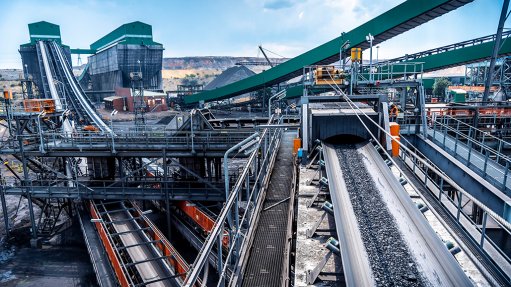
A Weba chute facilitates the transfer of coal ore through a conveyor
Designing transfer points to efficiently handle sticky materials is crucial for optimising material flow and minimizing downtime, says Weba Chute Systems.
Company technical director Alwin Nienaber explains that handling sticky material in mining and minerals processing plants can be a complex challenge, as the materials can cause blockages, equipment wear and increased maintenance requirements, leading to reduced efficiency and increased operational costs.
There are several key design considerations for transfer points, including material flow control, which are crucial to avoid blockages and build-up of sticky materials within chute systems.
“This is where chute geometry plays a significant role in handling sticky materials, with experience informing the design of a chute to minimise impact forces and reduce material degradation. Minimising is also important, and this can be achieved through the use of wear-resistant materials such as ceramic tiles or rubber linings, and further extend the service life of transfer points while reducing maintenance requirements,” he says.
Moisture levels also need to be controlled when handling sticky materials, as excessive moisture can exacerbate the stickiness of materials, leading to increased build-up and blockages, explains Nienaber. Moisture control strategies, such as proper drainage systems, dust suppression or material conditioning systems, can help maintain optimal moisture levels and improve material flow.
Material segregation and excessive particle size can also contribute to sticky material challenges at transfer points and strategies to minimise material segregation, such as proper stockpile management and the use of blending systems, can help maintain consistent material properties.
“Additionally, reducing particle size through controlled crushing or screening can help improve material flow and reduce the stickiness of the material,” Nienaber says.
Viewing transfer points holistically should also include attention to other aspects in materials handling such as belt cleaning systems which are vital for preventing carryback and will also reduce material build-up at transfer points, asserts Nienaber. Installing primary and secondary belt cleaners, along with belt tracking systems, can ensure that belts are free from sticky material carryback. This not only reduces the chances of blockages but also minimises belt wear and extends belt life.
“Implementing well-thought-out design strategies from an experienced transfer point OEM can certainly assist mining and minerals processing operations to optimise material flow, reduce equipment wear and maintenance requirements, and ultimately improve overall efficiency and productivity,” Nienaber concludes.